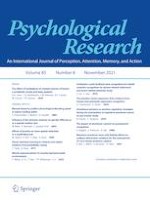04-01-2021 | Original Article
An investigation of “We” agency in co-operative joint actions
Gepubliceerd in: Psychological Research | Uitgave 8/2021
Log in om toegang te krijgenAbstract
Sense of agency refers to the sense that I am controlling an action or outcome, and is associated with a perceived compression of the temporal interval between these events known as intentional binding (IB). Though most IB studies focus on individually performed actions, some reveal the existence of shared implicit agency among joint actors, suggesting the formation of a shared “we” identity that may be sensitive to the intentions and actions of all actors. While current understanding of this shared agentic identity is far from clear, the present study used variants of the IB paradigm involving truly co-operative actions to investigate (1) the relative strength of individual and joint agency, and (2) whether different complementary roles modulate the sense of agency among joint actors. Experiment 1 compared the strength of agency for actions performed alone or with a partner, by instructing pairs of participants to press a key simultaneously to produce an auditory tone. Here, binding was weaker when performing jointly, but this may have been influenced by the demands of temporally co-ordinating actions. Experiment 2 removed these task demands by implementing joint actions that were not identical but complementary, and assessed the impact of varying roles (moving versus clicking a mouse) on agency. Here, binding was similar for independent and joint actions, and across all roles. These results support the notion of a shared “we” identity, suggesting that the joint sense of agency is as strong as individual agency and represents the intentions and actions of all co-actors.
